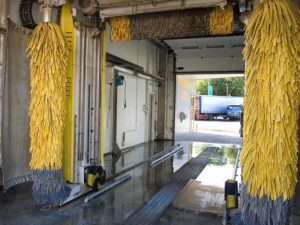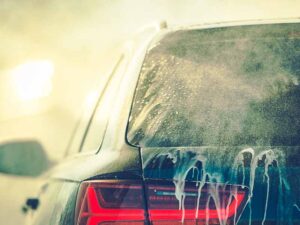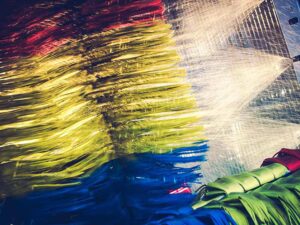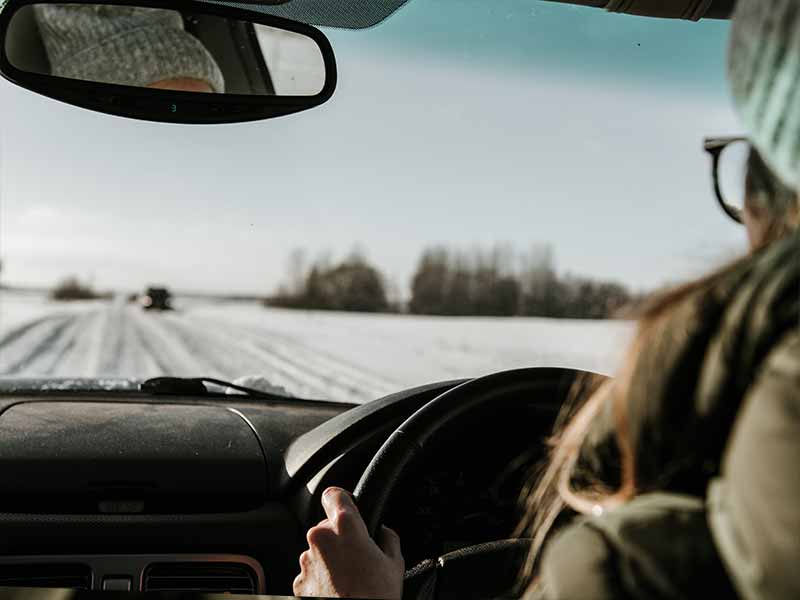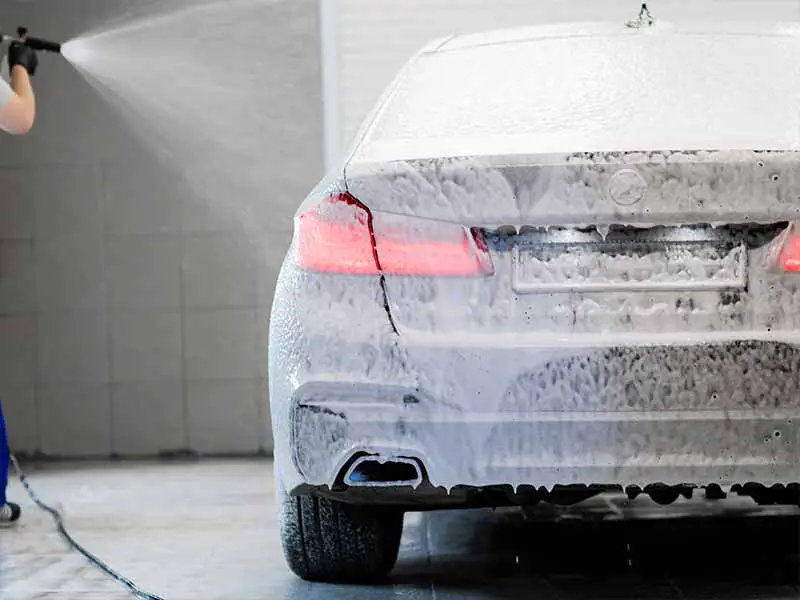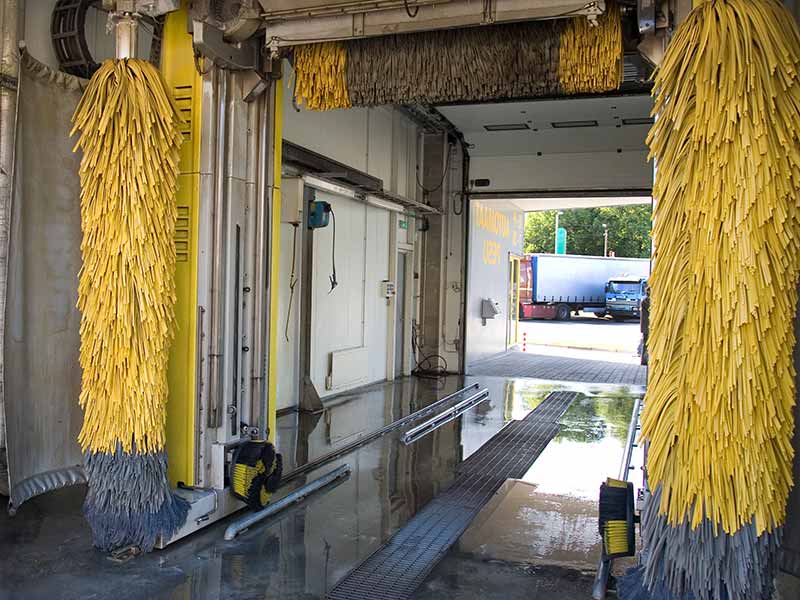Table of Contents
- Is Waterless Car Wash Safe?
- What Is a Waterless Car Wash?
- Waterless Wash Misconceptions
- How Does Waterless Car Wash Work?
- Using Waterless Car Wash: Step-By-Step Guide
- Times When Waterless Wash Isn’t Safe
- The Right Time to Use Waterless Car Wash Products
- You’ll Know When Your Car Is “Too Dirty”
- What Can You Wash with Waterless Car Wash?
- Helpful Links
- Conclusion
There are a lot of misconceptions surrounding waterless car wash products. Since it’s so easy and convenient to use, people wonder if it’s actually safe. Our team of professional detailers put together this guide to teach you everything you need to know.
We’ll cover what it is, how it works, how to use it, the proper uses, and whether or not it’s safe for your car.
Is Waterless Car Wash Safe?
Waterless washing is safe. Waterless car wash products will not scratch your paint, ruin your topcoat, or damage your car after long-term use.
As long as you perform the correct steps, use microfiber towels, and use a quality waterless wash product, you’ll get a safe, waterless clean.
What Is a Waterless Car Wash?
The term “waterless car wash” seems like a paradox. In a typical carwash, it’s just water and soap with a nice towel. How are you expected to wash your car without that soapy water?
Waterless car wash is a category of products that helps people clean their car. As the name suggests, there’s no water that you have to use. Instead, this sprayable product uses chemistry to clean your car.
More specifically, this is a product that you use without a bucket of water or soap at all. Instead, you apply this spray and wipe it away, and you’re left with a clean car.

Waterless Wash Misconceptions
Since this product works a lot like a car wash, it’s perfectly safe to use on your vehicle. After all, it is a product that’s made for cleaning cars with light levels of dirt and dust on them.
People are afraid that this product will scratch their paint or dissolve their car’s topcoat. These myths aren’t true.
There are a few ways that the process can be unsafe, but it’s easy to avoid these issues.
How Does Waterless Car Wash Work?
If you break down what goes into a waterless car wash, you’ll find a number of polymers and silicones. These chemicals go down to the root of the grime on your car and break the dirt apart.
It plays with the surface tension between your car and the dirt, dust, or oil on the topcoat of your car. Think of it like a spatula going underneath a pancake on the griddle.
The spray lifts the dirt, and then you wipe it away with a microfiber towel. Effectively, you just transferred all the dirt to the towel and away from your car.

Using Waterless Car Wash: Step-By-Step Guide
To help you understand how to safely use a waterless car wash, we put together this step-by-step guide. Follow along if you want to get the best results without scratching or streaking your car.
Step 1: Define the Section
It’s always best to apply a waterless car wash in sections. This means focusing on a single portion of your car, and not cleaning outside of the portion.
In general, we suggest sticking to a 1 ft x 1 ft section. You want to have a section that’s small enough so that the solution doesn’t dry on its own before you’re done wiping down the area.
In other words, the area will change depending on how quickly you work. Detailers with a lot of experience with waterless washes can commit to larger areas without compromising how good the final product looks.
Step 2: Prepare Your Towel
The second biggest consideration revolves around your towel. You’ll want to use a microfiber polishing towel. You can either use a brand-new towel or one that you recently cleaned.
The towel should be folded into quarters. This gives you 8 usable sides, which should be plenty for most detailers.
Grab one towel for washing and a few for drying.
Step 3: Spray Generously
Now you can start the cleaning process. You’ll want to spray a generous amount into the section you want to clean. There’s no such thing as “too much” waterless car wash applied, it just means more for you to dry off later. That being said, don’t be afraid to use extra solution.
Step 4: Wipe in One Direction
This is the critical difference between a traditional wash and using waterless car wash: you want to wipe in a single direction. In this step, you’ll be using the folded washing towel.
If you wipe in circles, you’re just smearing the dirt around. The solution you sprayed on the car will lift all the grime, so you want to be careful about how you remove it.
You also don’t need to apply a lot of pressure. In fact, using too much pressure will scratch your topcoat. Simply wipe the towel across the car and let the towel do all the work.
Step 5: Flip and Fold Your Microfiber Towel as Needed
When one section of your towel gets too dirty or saturated, just flip it to another clean side. Since you folded it in quarters, you can unfold the towel and refold it to get 8 usable surfaces.
If the entirety of your towel gets soiled, you can just grab another one and keep going.
If you forget to flip the towel after it gets too dirty, you’ll notice that it doesn’t work as well. You might also notice smears behind your towel as you continue working. It won’t cause any serious damage to your car, but it will make the waterless wash less effective.
Step 6: Dry it Off
Before moving to the next section, you’ll need to dry off this section completely. Without drying your car, you’ll probably notice streaks and a duller look after the job is finished. The best practice is to always dry your car when you wash it.
For drying, you should use a separate stack of towels that you didn’t use to clean the car in previous steps. Make sure you use microfiber towels, so you don’t scratch your car.
Step 7: Move to the Next Section
Now it’s time to repeat steps 3 through 6 for the rest of your car. After a few repetitions, you’ll get the hang of it. In the end, it’s pretty similar to how you would traditionally wash your car (without the water and with a directional wipe as you go).

Times When Waterless Wash Isn’t Safe
Here are some times that a waterless car wash product can be unsafe. Again, these are easy to avoid (which is why we claim waterless washes are safe in the first place).
Using the Wrong Waterless Wash Product
The first step is to pick out the product that you’ll be using. Opting for a knock-off brand or cheap alternative is never a good idea here. If the company uses the wrong combination of chemicals in their product, you can seriously scratch your car and damage your topcoat.
This is also a good time to mention that you should only use products that are labeled as a waterless (or no-water) car washer. Don’t use something like a Clorox wipe to do this cleaning. We love DIY solutions, but you should keep kitchen cleaners in the kitchen.
Using the Wrong Cloth
The next consideration is the cloth you’ll use for the cleaning. Using a dirty, used, or stiff cloth is not a good idea. The wrong cloth can do a lot of damage to your vehicle as well.
You should only use a microfiber cloth in this scenario. Preferably, you should use a new cloth or one that was just correctly cleaned.
If the cloth has an embedded piece of plastic or metal in its fibers, you’ll end up with a scratched-up car.
Using the Wrong Technique
Using the wrong technique is one of the more common pitfalls for DIY detailers. You should take some time to carefully read our step-by-step guide above. If you do that and follow our steps, you won’t have any problems.
If you simply pick up a can of waterless washer and a random cloth, then you could run into issues.
Applying too much pressure can create deep scratches on your topcoat. Doing circular motions with your cloth might scratch your car if you do it long enough.
Adding in Extra Chemicals
Some people are tempted to add more chemicals to the routine to get a better clean. This is most likely a bad idea. Grabbing the Windex to clean your paint will melt your topcoat and do irreversible damage to your car.
We suggest sticking with a waterless car washing product and that’s it. If it doesn’t fully clean your car, then it means your car is too dirty, so you need to do a traditional wash instead.
Getting creative in your cleaning cabinet is never a good idea when it comes to detailing your car.

The Right Time to Use Waterless Car Wash Products
There’s a major misconception about waterless wash products that we should clear up. People think that they can use this product as a regular substitute for traditional carwashes. This isn’t true.
A waterless car wash shouldn’t be used if your car is especially dirty. If you just went off-roading or drove across heavily salted roads, your car might be too dirty for this mixture.
The right time to use waterless car wash products is between car washes, or on a weekly basis when your car isn’t overly dirty.
In fact, the leading reason why waterless car washes scratch paint is due to improper use. Trying to use this spray on an especially dirty car would be categorized as “improper use” and can lead to scratching and swirling.
A lot of detailers might consider performing a waterless car wash before doing additional detailing steps like buffing, waxing, or a quick detail. Another good time to do a waterless wash is if you notice water spots on your car.
You’ll Know When Your Car Is “Too Dirty”
When it comes to waterless car washes, the term “too dirty” will continuously pop up. It’s hard to quantify when this term applies to your car or not.
After trying a waterless wash enough times, you’ll simply know when your car is too dirty. We’ve used this product on cars that were reasonably dirty, and the waterless wash worked perfectly.
If you want to try it on an overly dirty car, start with a small section and see how it looks after. You won’t do any damage by simply trying.
What Can You Wash with Waterless Car Wash?
A waterless car washing product can be pretty universal for your car. There are options on the market that are safe to use on your paint, windows, trim, plastic, and even your rims and wheels.
If any of these parts have a buildup of dirt and mud, then you won’t get a good wash. Rims and wheels are usually dirtier than the rest of the car. That means you should dedicate a separate towel for this section, but it might also mean that you can’t use a waterless washer on these areas.

Helpful Links
Conclusion
Waterless car washes are safe as long as you do it all properly. You can apply it to your vehicle to save you time, money, and keep your car looking nice.
Remember to use our steps, pick the right product, and use the right towels to get the best results for your waterless wash.
For more DIY detailing guides, take a look at the rest of our blog.


